MARIANI’S
Virtual Gourmet
JULY 31,
2016
NEWSLETTER
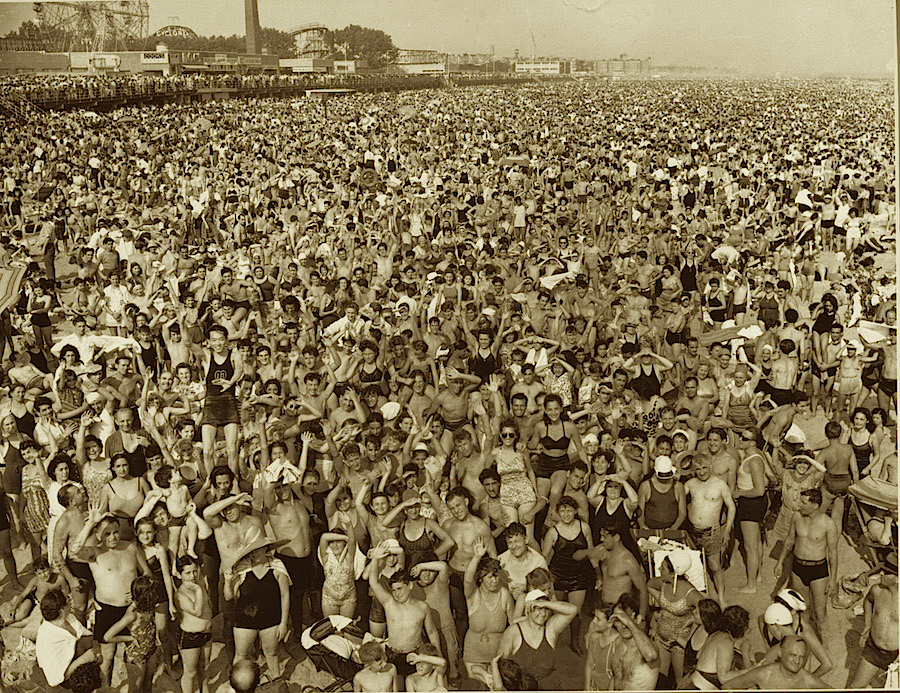
CONEY ISLAND, NY, circa 1950
IN THIS ISSUE
CROSSING THE POND ON
THE QUEEN MARY 2
By John Mariani
THE POWER LUNCH 2016
By John Mariani
NOTES FROM THE WINE CELLAR
PLEASANTRIES
By John Mariani
❖❖❖
CROSSING THE POND ON
THE QUEEN MARY 2
By John Mariani
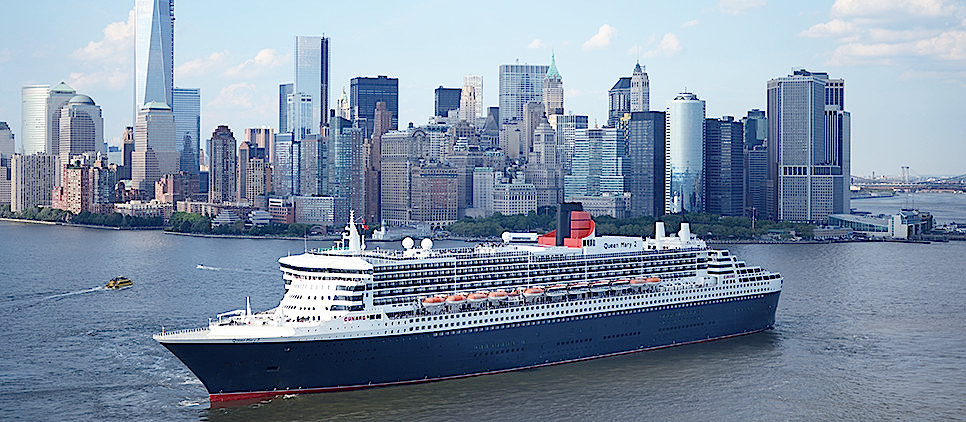
Twelve years ago I
went on a two-day cruise around Tampa Bay on the
then brand new Queen Mary
2, which joined the Queen
Elizabeth and Queen
Victoria as part of Cunard Line’s legacy
on the high seas that dates back to 1839. Sad
to report, while I found the ship itself
impressive, the food onboard was atrocious at a
time when it seemed oceanliners were just
beginning to improve their food and restaurants.
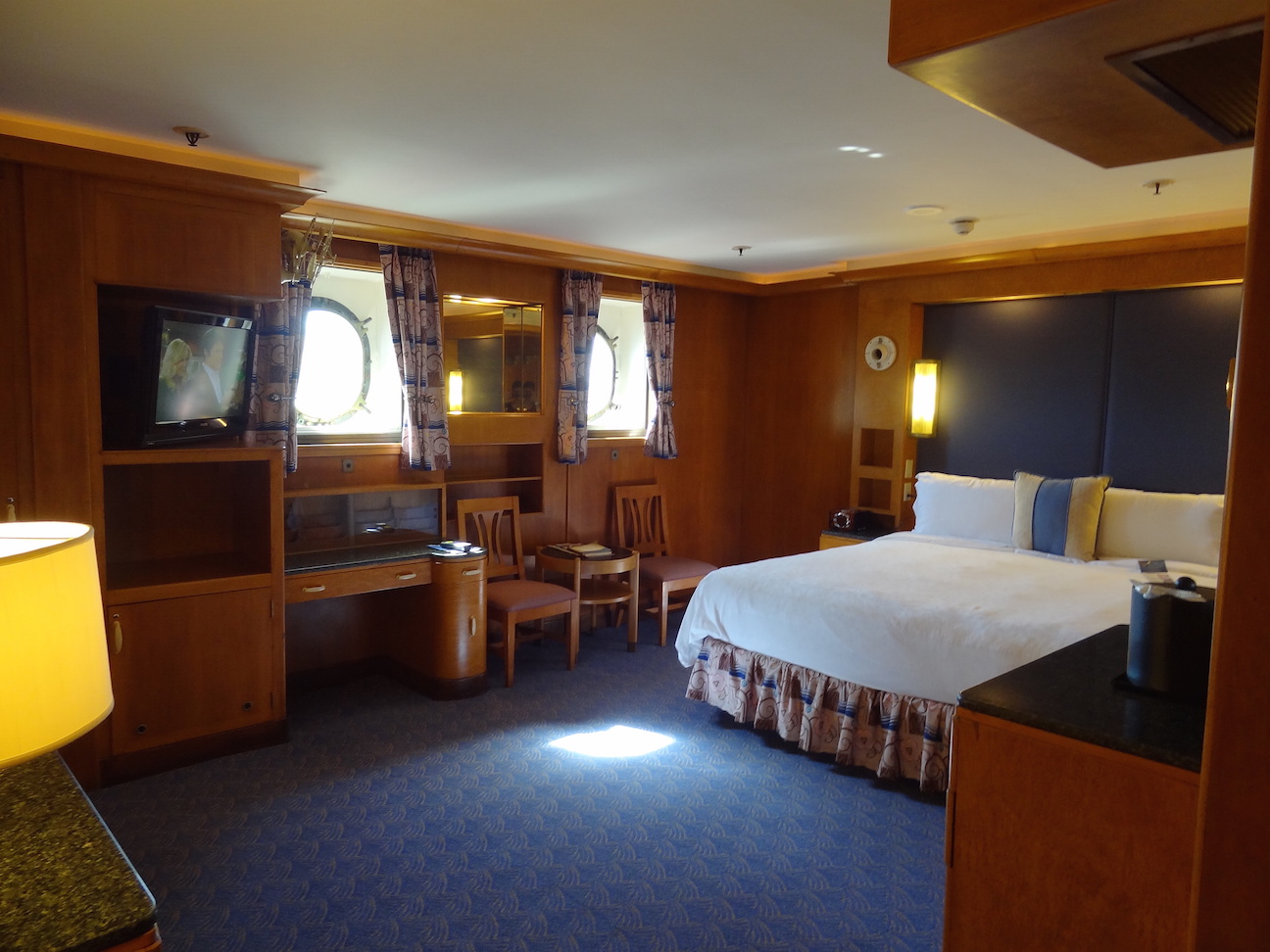 Then last
year I was invited to give two lectures aboard the
QM2 on
her Atlantic crossing out of Southampton, and I
leapt at the chance. My wife, who as a child was a
veteran of crossings on ships like the S.S. France, Flandre,
and Liberté,
found the idea of seven nights at sea a little
daunting, but I was thrilled to experience it for
the first time.
I was praying the food would be better.
Then last
year I was invited to give two lectures aboard the
QM2 on
her Atlantic crossing out of Southampton, and I
leapt at the chance. My wife, who as a child was a
veteran of crossings on ships like the S.S. France, Flandre,
and Liberté,
found the idea of seven nights at sea a little
daunting, but I was thrilled to experience it for
the first time.
I was praying the food would be better.
This past June the QM2 emerged
from a short make-over that brought in 6,500
pieces of new furniture, 4,000 new works of art,
438,00 square feet of new carpet, even ten more
pet kennels.
Prices for this season, which ends in the
fall (when the ship switches to warm water ports
of call) run from $1,653 for inside rooms up to
$21, 210 for the most posh of accommodations. All
include room, food, pool and gym, and all
entertainment, which 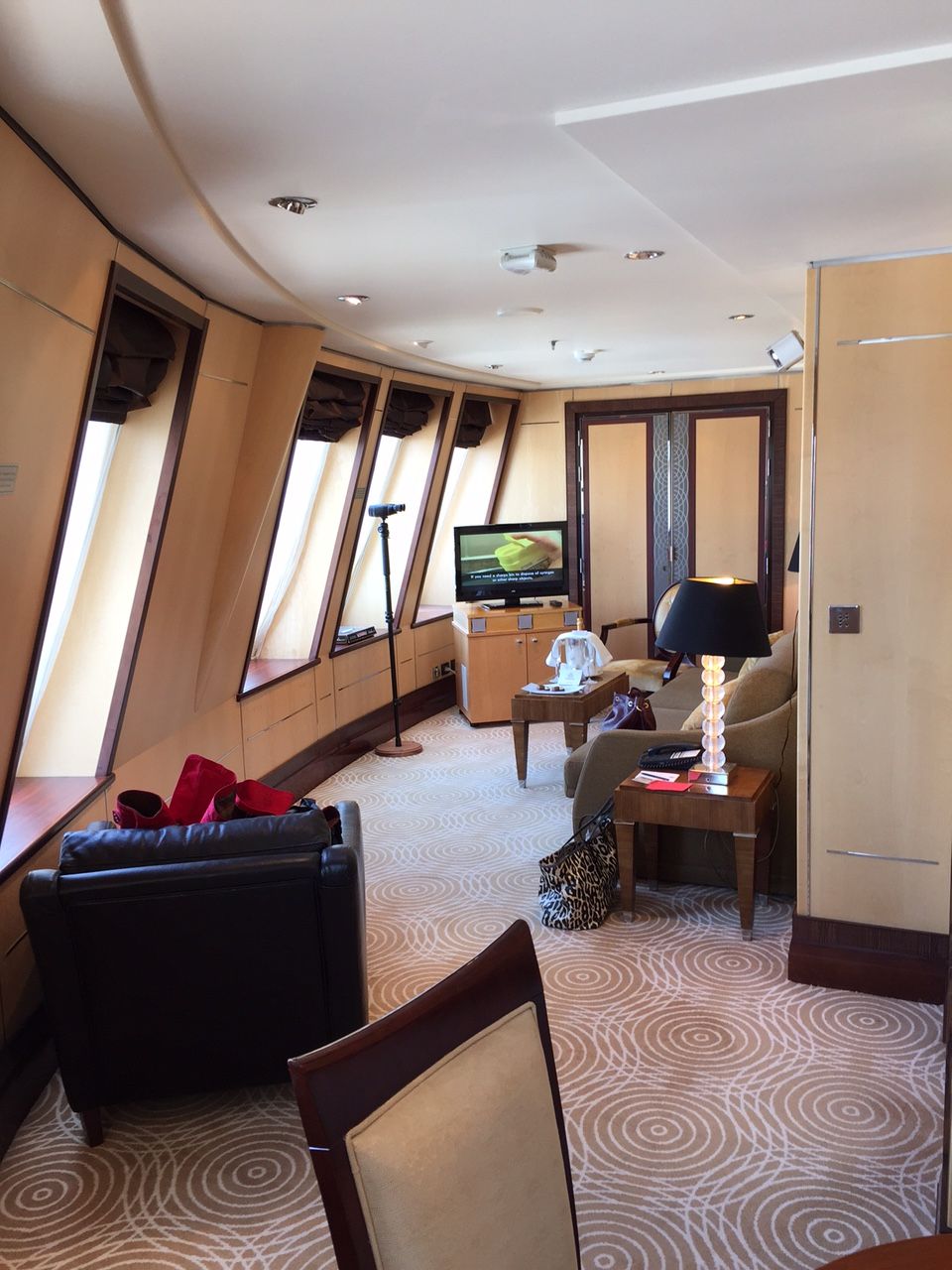 ranges from first-run movies and
amazingly good Broadway-style musicals to a
Shakespearean play.
The lowest fares are hard to believe for
their economy, but even were you to pay $10,000 or
more, you get far more luxury, service, and
entertainment that you could expect for seven
nights at even a mediocre hotel, restaurants, and
shows in London or NYC. No wonder, then, that this
season’s crossings are almost sold out.
ranges from first-run movies and
amazingly good Broadway-style musicals to a
Shakespearean play.
The lowest fares are hard to believe for
their economy, but even were you to pay $10,000 or
more, you get far more luxury, service, and
entertainment that you could expect for seven
nights at even a mediocre hotel, restaurants, and
shows in London or NYC. No wonder, then, that this
season’s crossings are almost sold out.
Our arc-shaped stateroom suite
(left and above)
looking out over the prow of the ship, with a
modern art deco refinement, was exceptionally
well-designed, from the bedroom, with King size
bed, spacious and walk-in clothes and luggage
closet—no need to slide bags under the bed!—to a
well-equipped bathroom roomy enough to move around
in easily.
Service throughout, from our
butler to the restaurant workers drawn from a wide
range of internationals speaking many languages,
were clearly trained in the British way of
hospitality: Remember that Lord Nelson demanded
that “England expects every man to do his duty” on
an English ship, even if the crew are mainly
from Slovenia and Rumania.
The options for dining seem
endless, at least until you’ve eaten onboard for
five days. The
two top-tier dining rooms, tied to your package,
are the Queen’s Grill and the Princess Grill,
where, as is the custom, you dine with the same
people every night.
(You may ask to dine alone, and there were
some who did, described by the staff as people who
more or less spend their entire year cruising the
world.)
We ate
each evening in the beautiful Princess Grill (right), where
we were extremely fortunate to have six tablemates
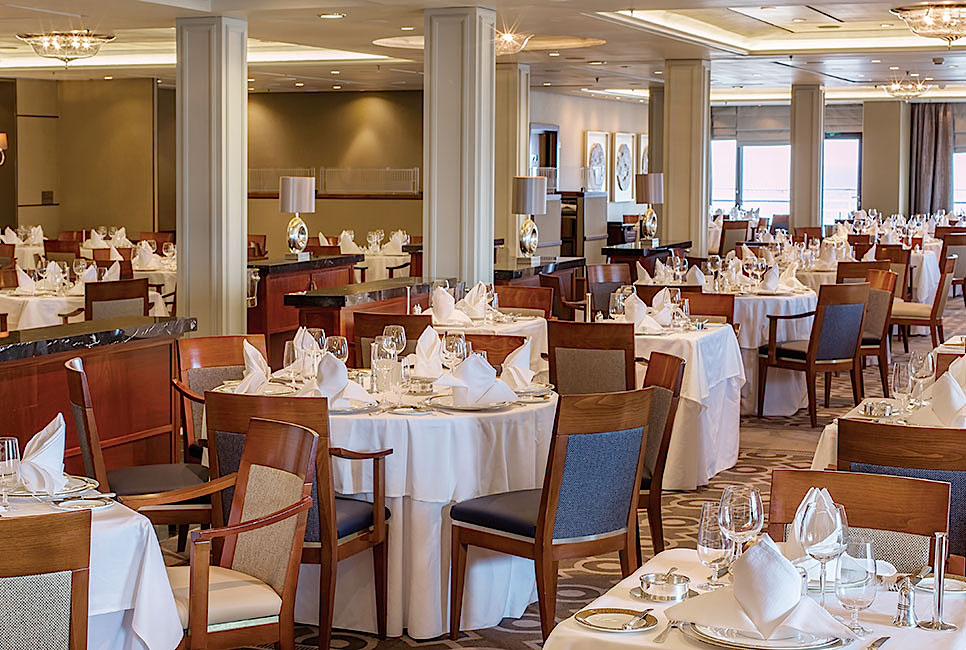 who could
not have been more diverse or more affable, including
two Californians, a movie stunt coordinator and
his wife, and two jolly retired Brits. We’d
usually start with cocktails at the always packed
Commodore’s Club lounge, whose bartenders get to
know your cocktail preference on the first night,
then proceed to dinner, where three nights were
black tie. The
food was for the most part very good, as were the
wine choices, though, except for one special each
night, the menu never changed, so that four nights
in, we had pretty
much ran through everything on it. But
it’s no hardship to have fine lamb chops or Dover
sole twice in a week. The cheese and dessert
offerings were excellent, too.
who could
not have been more diverse or more affable, including
two Californians, a movie stunt coordinator and
his wife, and two jolly retired Brits. We’d
usually start with cocktails at the always packed
Commodore’s Club lounge, whose bartenders get to
know your cocktail preference on the first night,
then proceed to dinner, where three nights were
black tie. The
food was for the most part very good, as were the
wine choices, though, except for one special each
night, the menu never changed, so that four nights
in, we had pretty
much ran through everything on it. But
it’s no hardship to have fine lamb chops or Dover
sole twice in a week. The cheese and dessert
offerings were excellent, too.
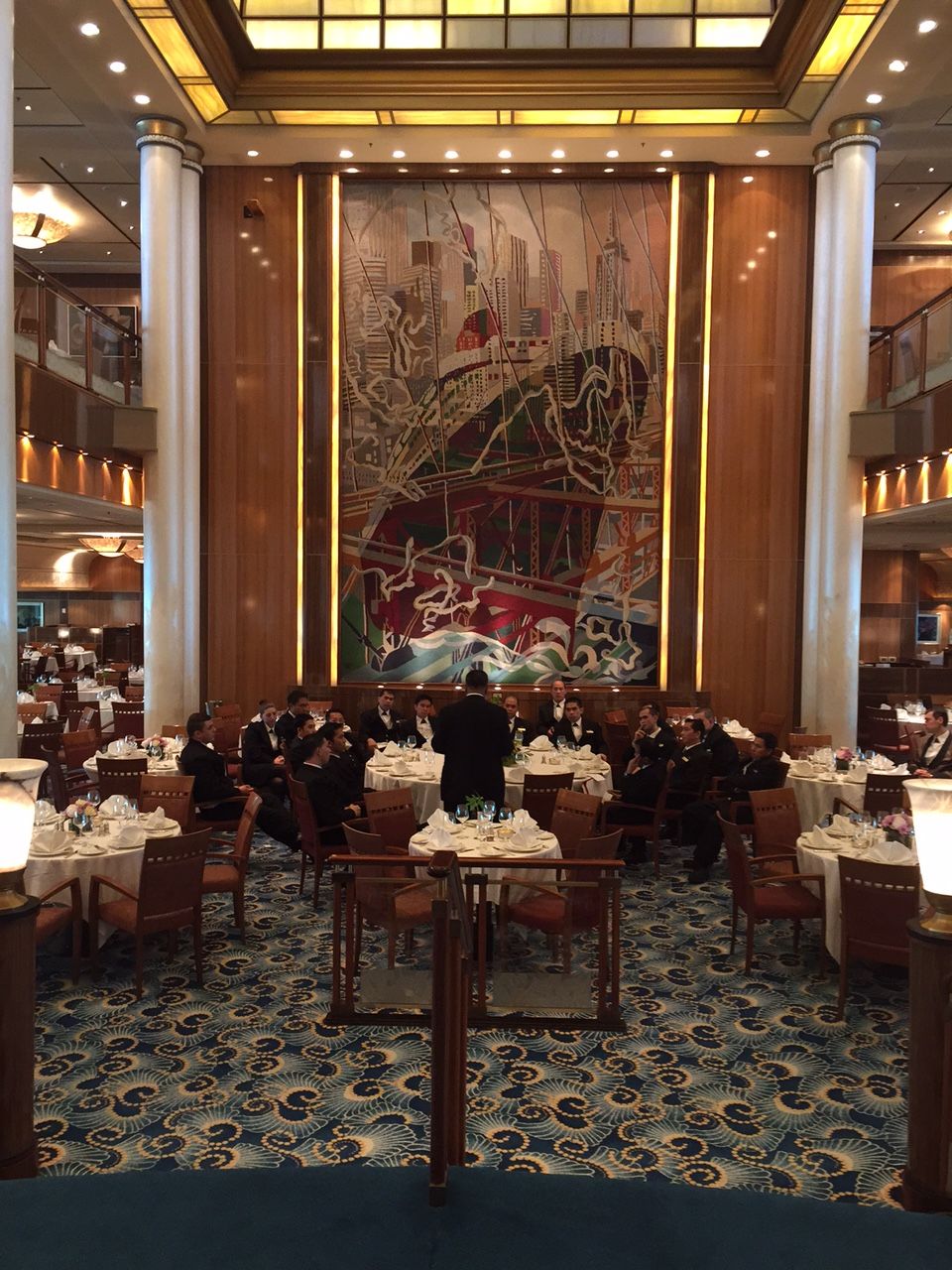 The menu at the more
glittery Queen’s Grill is the same, and I see from
the current menus that they’ve also added some
Canyon Ranch Spa Selections, with calorie counts,
though to me the idea of not splurging on the Queen Mary 2
is like driving an Aston Martin at the speed
limit. The
Brittania Club restaurant (left) set for
lunch is exceptionally handsome and sunny—when it is
sunny—and the menu more or less overlaps with
those at the Grills. The King’s Court is where
most people have breakfast, lunch and dinner and
everything in between. It’s a huge place with
tandem dining areas and the look of a cafeteria,
which it is, and among the various stations there
is hardly a cuisine or any kind of food you won’t
find every day, from pancakes and freshly made
eggs, to pizza and sushi, from Thai spring rolls
to Indian curries, from New York-style sandwiches
to London-style bubble-and-squeak. I must
say I was very impressed with the quality, not
least because all the food had been brought aboard
in Southampton (reprovisioned in NYC), yet
freshness was never an issue.
The menu at the more
glittery Queen’s Grill is the same, and I see from
the current menus that they’ve also added some
Canyon Ranch Spa Selections, with calorie counts,
though to me the idea of not splurging on the Queen Mary 2
is like driving an Aston Martin at the speed
limit. The
Brittania Club restaurant (left) set for
lunch is exceptionally handsome and sunny—when it is
sunny—and the menu more or less overlaps with
those at the Grills. The King’s Court is where
most people have breakfast, lunch and dinner and
everything in between. It’s a huge place with
tandem dining areas and the look of a cafeteria,
which it is, and among the various stations there
is hardly a cuisine or any kind of food you won’t
find every day, from pancakes and freshly made
eggs, to pizza and sushi, from Thai spring rolls
to Indian curries, from New York-style sandwiches
to London-style bubble-and-squeak. I must
say I was very impressed with the quality, not
least because all the food had been brought aboard
in Southampton (reprovisioned in NYC), yet
freshness was never an issue.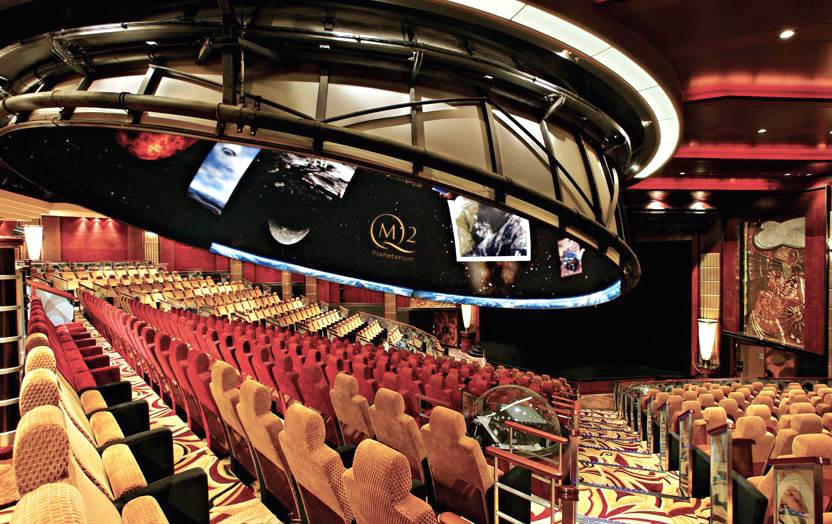
After
all the days at sea, the dips in the pool, tea
time, movies, quiet visits to the library,
lectures, and even a daunting Planetarium show (right), our
urge to get on American terra firma had set in. Dutifully
getting up just before dawn, we joined the throngs
outside to watch the sun silently creep up over
the magnificent New York skyline stretching from
Brooklyn to Staten Island, with Lady Liberty in
the harbor, holding her torch aloft. I half
expected them to play “Rhapsody in Blue.”
I had never seen New York from
out at sea, and I suddenly felt that the gorgeous
lines William Wordsworth had penned back in 1802
about London’s Westminster Bridge could not have
been more aptly applied to New York:

Earth has not anything to show more fair:
Dull would he be of soul who could pass by
A sight so touching in its majesty:
This City now doth, like a garment, wear
The beauty of the morning; silent, bare,
Ships, towers, domes, theatres, and temples lie
Open unto the fields, and to the sky;
All bright and glittering in the smokeless air. .
. .
Ne'er saw I, never felt, a calm so deep!
The river glideth at his own sweet will:
Dear God! the very houses seem asleep;
And all that mighty heart is lying still!
There
were a few eccentric people onboard who never
disembarked from the QM2 and
intended to sail back to England that afternoon,
but for me the cruise had been just enough to make
indelible impressions on me, so that I would
probably never repeat it, content in the way I was
once to join Mardi Gras in New Orleans and the
Fourth of July fireworks in NYC. My time
onboard was unforgettable but never fleeting, and
I feel that a second voyage might sap the wonder
of it all.
❖❖❖
THE POWER LUNCH 2016
By John Mariani
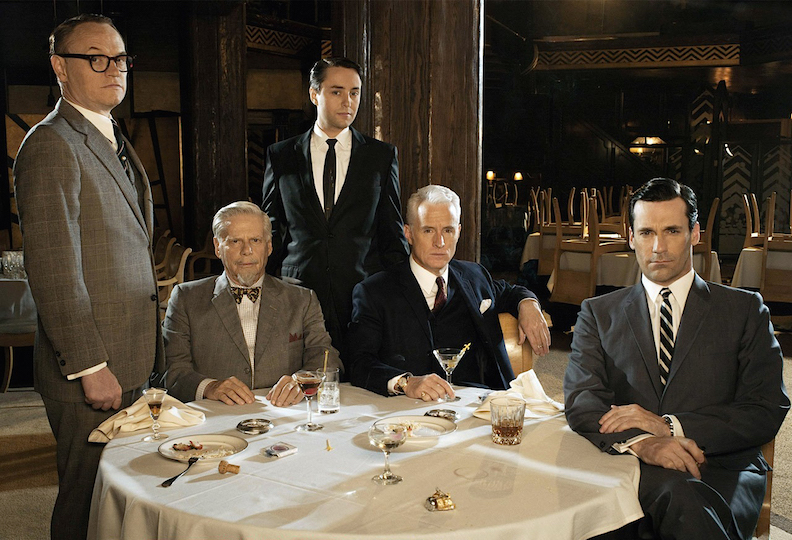
Last week Eater.com and its “partner,” Vox
Creative, came out with a list of New York’s top
Power Lunch restaurants, yet, with only three
exceptions, few would ever be considered for a
serious business lunch, where the emphasis is on
business and lunch is secondary. The
Power Lunch thrives in NYC as nowhere else 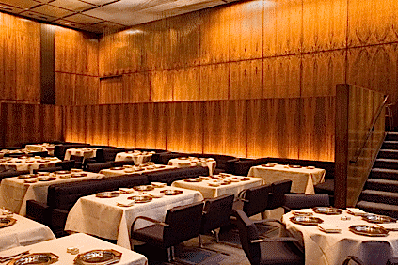 in the U.S. in
restaurants that have been around for a very
long time, including the just-closed Four
Seasons in the Seagram Building. Indeed,
the term Power Lunch was concocted by Lee
Eisenberg in an Esquire
magazine story (October 1979) entitled “America’s
Most Powerful Lunch” about the Four Seasons (left), to
the point of showing the Grill Room’s lay-out
and who usually sat where.
in the U.S. in
restaurants that have been around for a very
long time, including the just-closed Four
Seasons in the Seagram Building. Indeed,
the term Power Lunch was concocted by Lee
Eisenberg in an Esquire
magazine story (October 1979) entitled “America’s
Most Powerful Lunch” about the Four Seasons (left), to
the point of showing the Grill Room’s lay-out
and who usually sat where.
Earlier, in March 1976, the “Power
Breakfast” was unofficially inaugurated (though
the term was not used until 1980) at the Regency
Hotel’s 540 Park Restaurant (below) by
Preston Robert Tisch, president of the Loews
Corporation, as a way for businesspeople to fit in
an early meeting before the regular business day
began. For the privilege of having breakfast—some
regulars fit in two successive meetings—at what is
now called the Regency Bar & Grill, you will
pay $25 for eggs 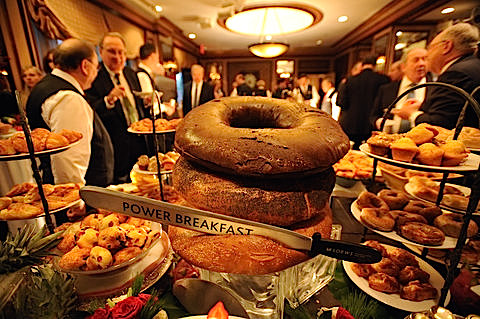 “any style,” $18 for
yogurt with Granola, and $22 for pancakes. But as
someone said of the outrageous prices for the
food, “You can’t really complain about the price,
because it’s cheaper than office space.”
“any style,” $18 for
yogurt with Granola, and $22 for pancakes. But as
someone said of the outrageous prices for the
food, “You can’t really complain about the price,
because it’s cheaper than office space.”
After the Esquire
article, the term Power Lunch caught on fast, and
many restaurants sought to be part of the idea,
including the well-established `21’ Club, a branch
of the L.A.-based Michael’s, steakhouses like
Sparks and Patroon, and high-end French places
like Le Cirque in midtown; downtown in the Wall
Street area private dining clubs were more popular
for business lunches.
The reason places like these were chosen
was always about access and recognition from the
restaurants’ owners and staff, preferential
seating, and the ability always to get a table.
From such considerations grew the idea of the
“negative reservation,” which referred to a
businessperson who dined most days of the week at
an individual restaurant and called to relinquish
their table only on those days they would not be
coming.
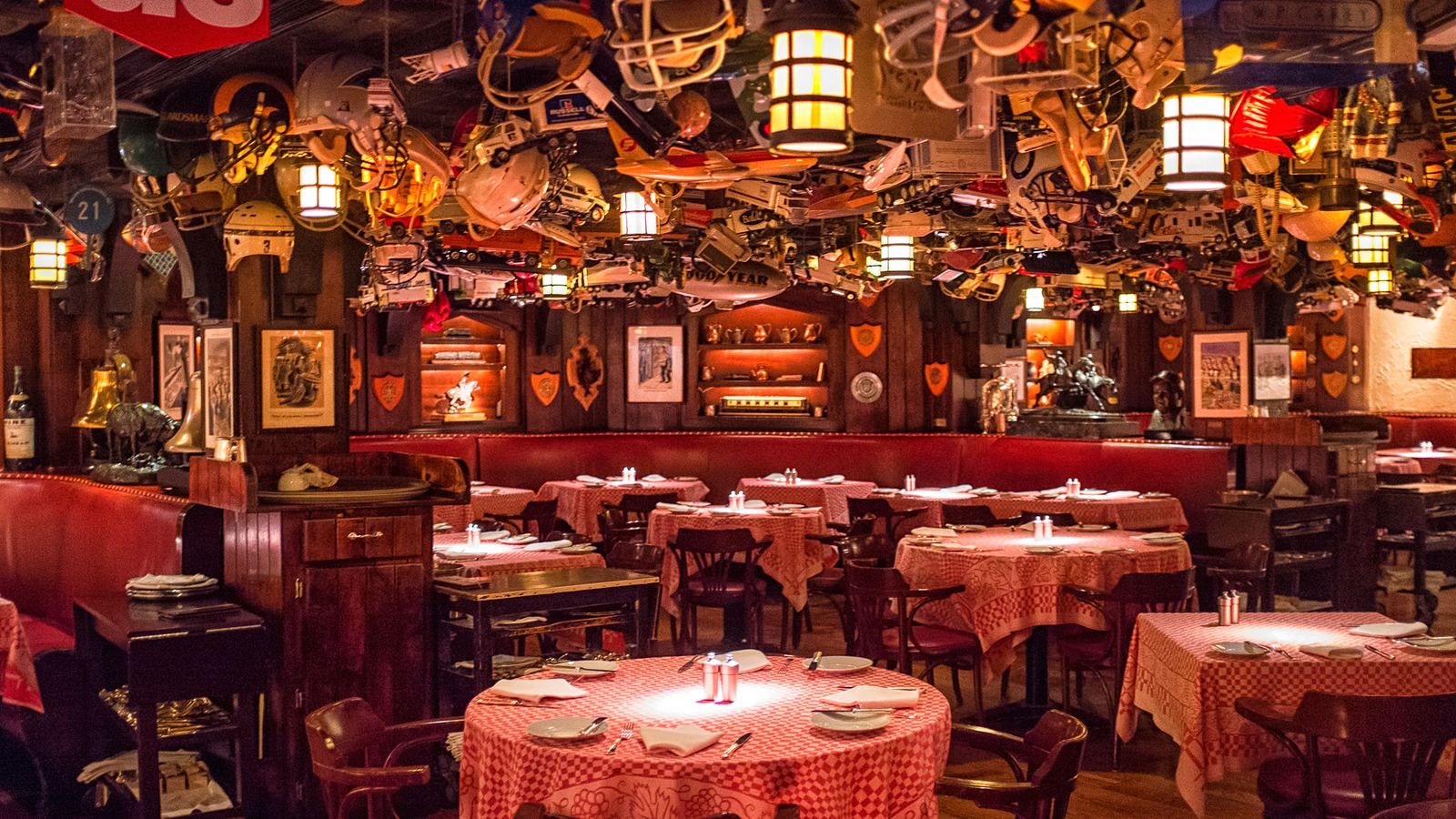 In such restaurants
territory was critical to image: at the Four
Seasons it was the Grill Room, at ‘21’ the first
dining room by the bar (left), festooned with
corporate toys. Being relegated to “Siberia” would
be considered a demotion by one’s peers. That term
originated in the 1930s, when a society woman
named Peggy Hopkins Joyce (below)
entered the class-conscious El Morocco nightclub
in NYC and found herself being led to a less than
desirable table. “Where are you taking me,” she
asked the maître d’hôtel, “Siberia?” Thus,
the contortions and extortions that take place to
assure being seated at an “A” table can be fierce.
In such restaurants
territory was critical to image: at the Four
Seasons it was the Grill Room, at ‘21’ the first
dining room by the bar (left), festooned with
corporate toys. Being relegated to “Siberia” would
be considered a demotion by one’s peers. That term
originated in the 1930s, when a society woman
named Peggy Hopkins Joyce (below)
entered the class-conscious El Morocco nightclub
in NYC and found herself being led to a less than
desirable table. “Where are you taking me,” she
asked the maître d’hôtel, “Siberia?” Thus,
the contortions and extortions that take place to
assure being seated at an “A” table can be fierce.
It
should be noted that an “A” table is not always
the same thing in a celebrity-rich or fashionable
restaurant as it is in a Power Lunch. At the former
the most conspicuous table is the most coveted; at
the latter, discretion is more the rule, and
having distance between your table and your
competitor’s in the same industry is assumed.
is in a Power Lunch. At the former
the most conspicuous table is the most coveted; at
the latter, discretion is more the rule, and
having distance between your table and your
competitor’s in the same industry is assumed.
Every
maître d’ can tell horror stories of being
harangued by old and new guests for a very
specific table, even if someone is already sitting
there. The
young Sirio Maccioni, later owner of Le Cirque, on
his first day as maître d’ at the high society
restaurant The 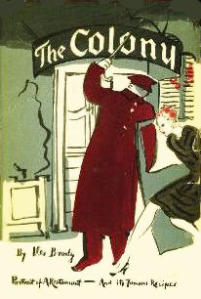 Colony back in the 1960s
had to cope with Frank Sinatra, Cary Grant and
Aristotle Onassis all coming for lunch and
assuming they would get their regular table—the
same one for each of them. Sinatra
was not happy but moved, Grant was wholly
gracious, Onassis got the table but griped anyway. (One
can only imagine Rick’s dilemma in the movie
“Casablanca” when freedom fighter Lazlo asks him
for a table “as far away from [Nazi] Major
Strasser as possible,” to which Rick wryly
remarks, “Well, the geography may be a little hard
to arrange.”)
Colony back in the 1960s
had to cope with Frank Sinatra, Cary Grant and
Aristotle Onassis all coming for lunch and
assuming they would get their regular table—the
same one for each of them. Sinatra
was not happy but moved, Grant was wholly
gracious, Onassis got the table but griped anyway. (One
can only imagine Rick’s dilemma in the movie
“Casablanca” when freedom fighter Lazlo asks him
for a table “as far away from [Nazi] Major
Strasser as possible,” to which Rick wryly
remarks, “Well, the geography may be a little hard
to arrange.”)
Lunch at fashion industry
favorites like Polo Bar by Ralph Lauren is much
more a matter of seeing and being seen than
deal-making. But a Power Lunch is always a
business lunch, even if little business is
actually discussed, and for this reason, the
trendier, the noisier, the more out-of-the-way and
the more extenuated 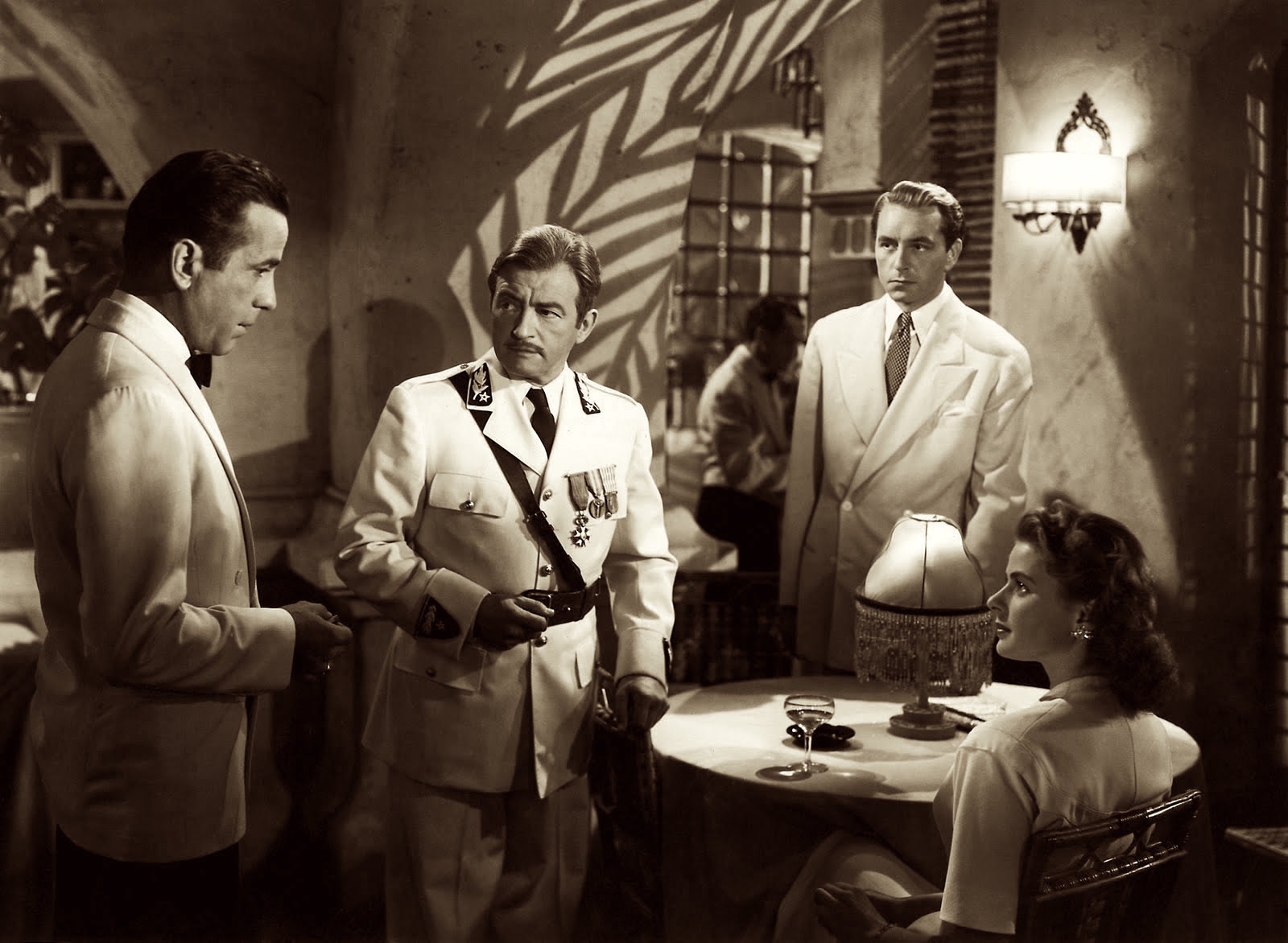 the meal, the less useful it is for
business. The
food should never dominate, and the Three Martini
Lunch has been dead and gone for two decades now. You’ll
now find far more bottled water and iced tea on
the table than even a glass of wine.
the meal, the less useful it is for
business. The
food should never dominate, and the Three Martini
Lunch has been dead and gone for two decades now. You’ll
now find far more bottled water and iced tea on
the table than even a glass of wine.
Just
to show how unimportant food was to his business
lunches at Le Cirque, the monstrous power-mad
lawyer Roy Cohen would emerge from his limo
carrying a bag with his own lunch and iced tea in
it, which he handed to the maître d’ to have
plated. And,
of course, everyone remembers the line in the
movie “Wall Street” (below) when Gordon Gekko invites
his acolyte to `21’ and five minutes later leaves
him at the table, snarling, “Lunch is for wimps.”
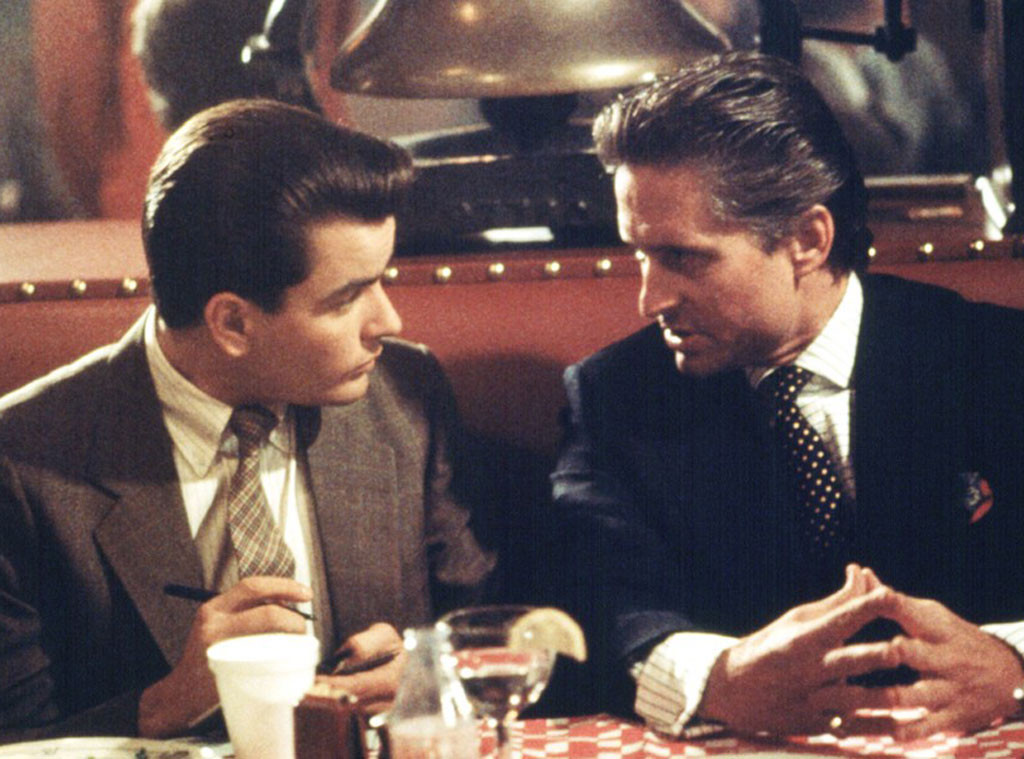
So, I was amazed to find the Power Lunch spots in
the Eater.com/Vox Creative article so out of tune
with the established rubrics of what a Power Lunch
is really about: “The
iconic
restaurants and traditions remain, but the idea of
what power lunch means today has shifted
significantly. For many, that rare-yet-cherished
working lunch is more kale salad than mid-day
porterhouse. And the power lunch spots of
yesterday no longer attract the elite and
powerful, as seen by the ever-changing trends and
restaurant openings in New York. (In case you were
wondering, ramen, raw bars, and tasting menus are
in for the lunch crowd).”
The
article does mention `21’ Club, Odéon and Betony,
but the rest are so fraught with problems for the
Power Lunch crowd that they are clearly better
suited for those willing to wait for a seat at the
counter or to endure a gargantuan three-hour meal. Thus,
at Ippudo in the East Village, Eater.com/Vox
Creative writes: “Get
there early for lunch — no reservations, and eager
lovers of the noodle soup will most certainly
guarantee you a wait — and settle in for a ramen
bowl, rice bowl, and small salad for lunch.”  At Eleven Madison Park (right), lunch
is a seven-course affair: “Be forewarned—a table
for two at lunch, without the wine pairing will
cost you nearly $1,000 with service and taxes. But
this is power lunch 101: So order the wine
pairings and ease into a decadent meal.”
At Eleven Madison Park (right), lunch
is a seven-course affair: “Be forewarned—a table
for two at lunch, without the wine pairing will
cost you nearly $1,000 with service and taxes. But
this is power lunch 101: So order the wine
pairings and ease into a decadent meal.”
Since the average Power Lunch meal in
Midtown costs roughly $50 per person, a tab like
Eleven Madison Park’s would be quite a stretch
even for an investment banker on a roll, not to
mention a Brazilian billionaire who never eats
lunch before two PM.
Balthazar does get a good business
breakfast crowd, but its hugeness, its frenzied
atmosphere and ear-splitting noise do not make it
an ideal spot to discuss mergers and acquisitions. And I
wince at Eater.comn/Vox Creative’s notion
that “Nothing says power lunch more than a lobster
bib.”

For any business
person not located way over west in the Village,
High Street on Hudson would be a trek during midday,
when traffic is at its worst. Still
Eater.com/Vox Creative calls it “the new
powerhouse lunch spot. If you’re there before
11:30 a.m. (official lunch hour), feast on an
elevated breakfast sandwich or pick from the
stunning selection of pastries.” Does the photo
of High Street on Hudson below look ideal for a
serious business lunch?
Santina, inconveniently located
even farther west under the High Line, is “an easy
yet trendy place to make your sprawling group
lunch into an extended afternoon event.” The NY Times critic
called Santina’s sound level “oppressive at peak
capacity”—just the place to have a face-to-face
with 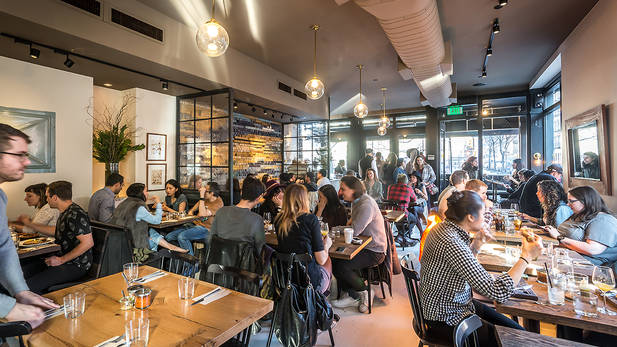 your toughest client!
your toughest client!
Lure Fish Bar’s “lively atmosphere brings
Manhattan’s media elite to this Soho hotspot” for
“a taste of the yacht life [in] a subterranean
dining room designed to look like the boat of your
dreams,” which might be fun after you clinch your
multi-million dollar deal at a quieter venue
uptown.
Eater.com/Vox Creative is certainly correct
that their choices are widely popular, the food
very good, and they might be great fun for after
hours business entertaining on expense account,
perhaps followed by karaoke. But I
doubt even a VP of Marketing for Stella McCartney,
Rag + Bone or Lululemon in the Meat Packing
District is going to try to bring in business over
saketinis at
Spice Market or Fatty Crab.
Like
most
listicles in the foodie media these days, heat and
buzz mean everything and anything, two terms
antithetical to the Power Lunch crowd, for whom
the last thing they want to hear over the booming
sound system is Wiz Khalifa and Big Sean while a
waiter explains why it’s taking fifteen minutes to
get a chicken fajita.
By John Mariani
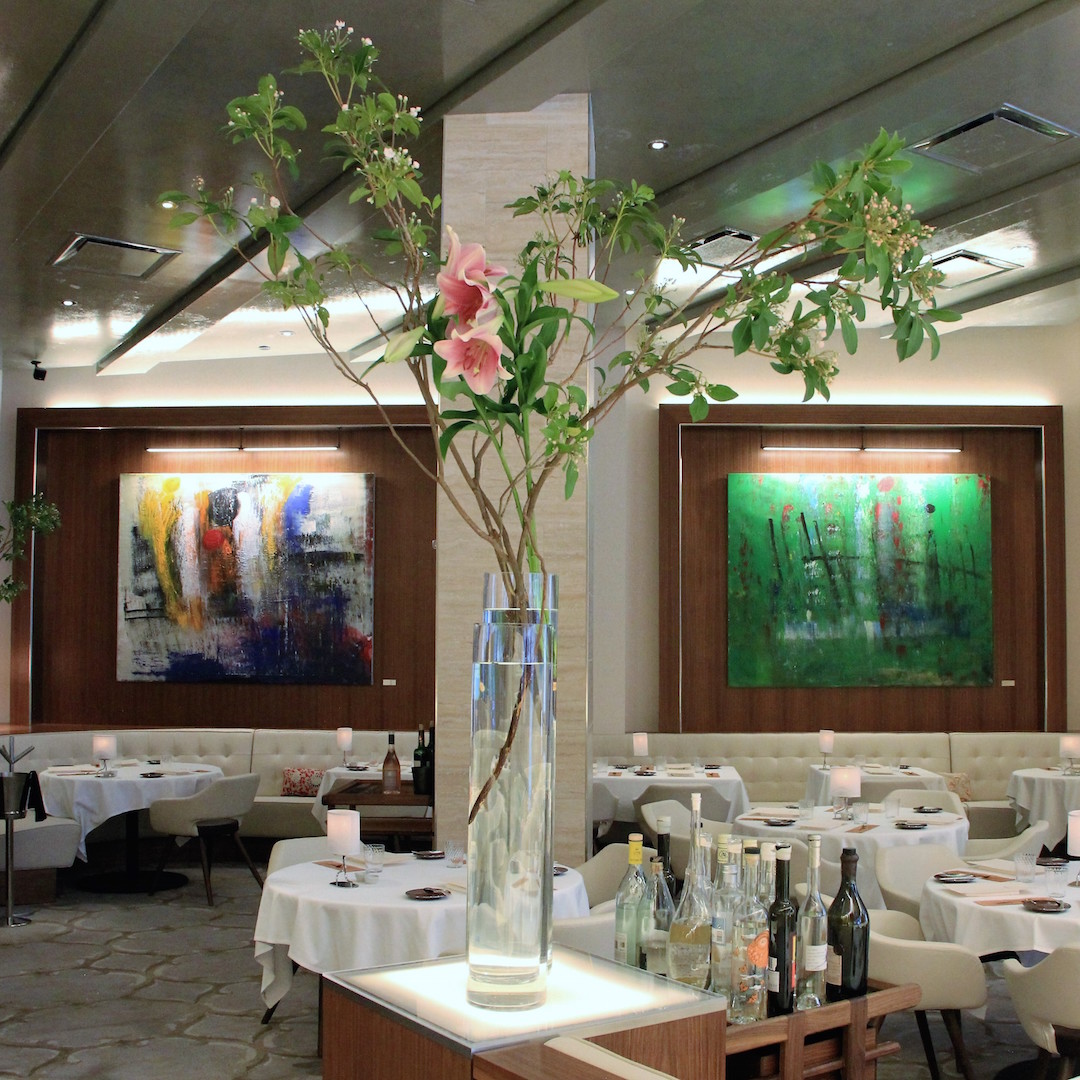 GABRIEL
KREUTHER
GABRIEL
KREUTHER
41 W 42nd Street (near Fifth Avenue)
212-257-5826
www.gknyc.com
For
the moment, let me say nothing at all
about the food at Chef Gabriel
Kreuther’s namesake restaurant across
from Bryant Park. Instead let me focus
in on what this splendid, year-old
restaurant represents in 2016.
When it
opened, the food media questioned whether a
restaurant of this high style and refinement
would garner a clientele at a time when it was
presumed people had moved away from fine
dining in preference to downtown eateries with
brick walls, barn wood tables, t-shirted
waiters and cacophonous music. The question
was hardly worth posing, for in the two years
preceding the opening of Gabriel Kreuther, New
York saw the debut of Nomad, Betony, Morini,
and the re-configured Eleven Madison Park, all
opened to great acclaim and packed houses.
Given Kreuther’s résumé and
reputation at restaurants like Jean-Georges
and The Modern, there seemed every reason to
believe his restaurant would succeed
admirably. And it has indeed. GK, as I’ll call
it, has become one of NYC’s most respected and
popular midtown restaurants—with one Michelin
stars and three from the NY Times—in
both
its 100-seat main dining room and its amiable
bar-lounge area. 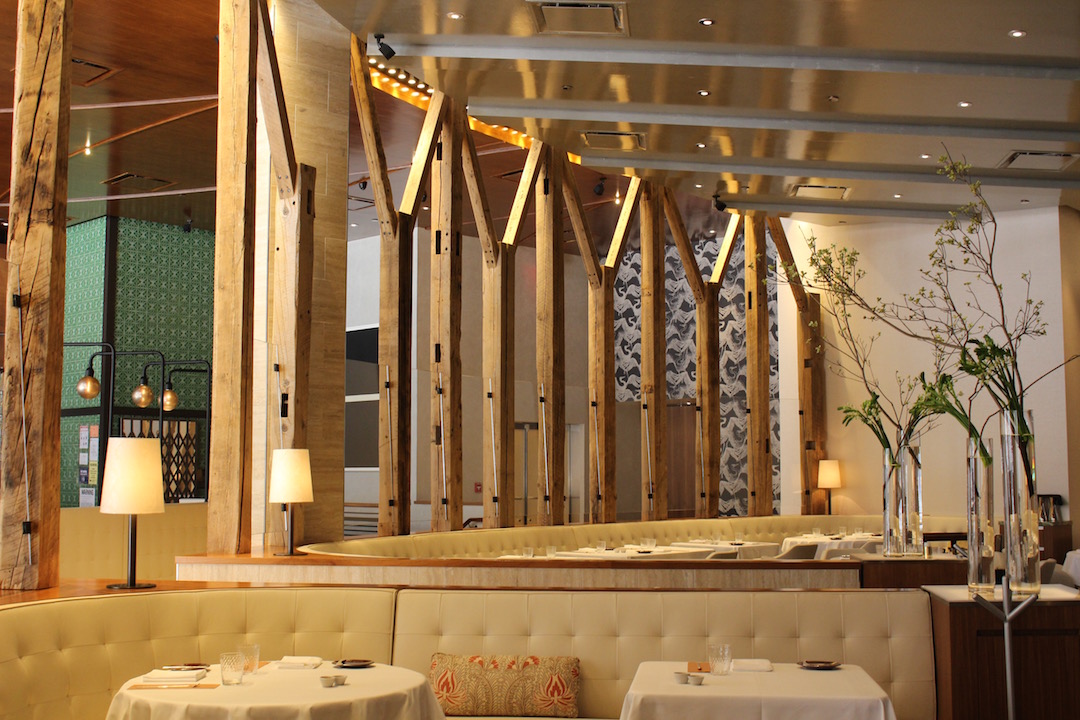
Prices for the four-course
prix fixe dinner have angled upward since last
year, now $125, with
too many supplements, but they’re
still below those at comparable venues like Le
Bernardin’s $147 (four courses), Daniel’s $142
(four) and Jean-Georges’ $138.
And what do you get for
your money, which is about one-fifth the price
of a ticket to “Hamilton”? First,
a most civilized young waitstaff, not least
manager Thierry Chouquet and wine director
Emily Perrier, all impeccably dressed, never
intrusive, always knowledgeable.
GK’s flowing dining
spaces, including a chef’s table near the
kitchen, are inspired by the town squares in
Alsace, whence Kreuther hails, with street
lamp light fixtures, huge wooden beams, an
etched-glass wall adorned with stork imagery,
and a stainless-steel bar top. The
retro-style chairs are extremely comfortable,
the lamp-lighted tables are set with thick
white linens and napkins, so the acoustics
make for very civilized conversation. (The
elongated and awkward silverware still strikes
me as more apt for a fondue set.) Now
a year into its prime, the place looks fresher
than ever.
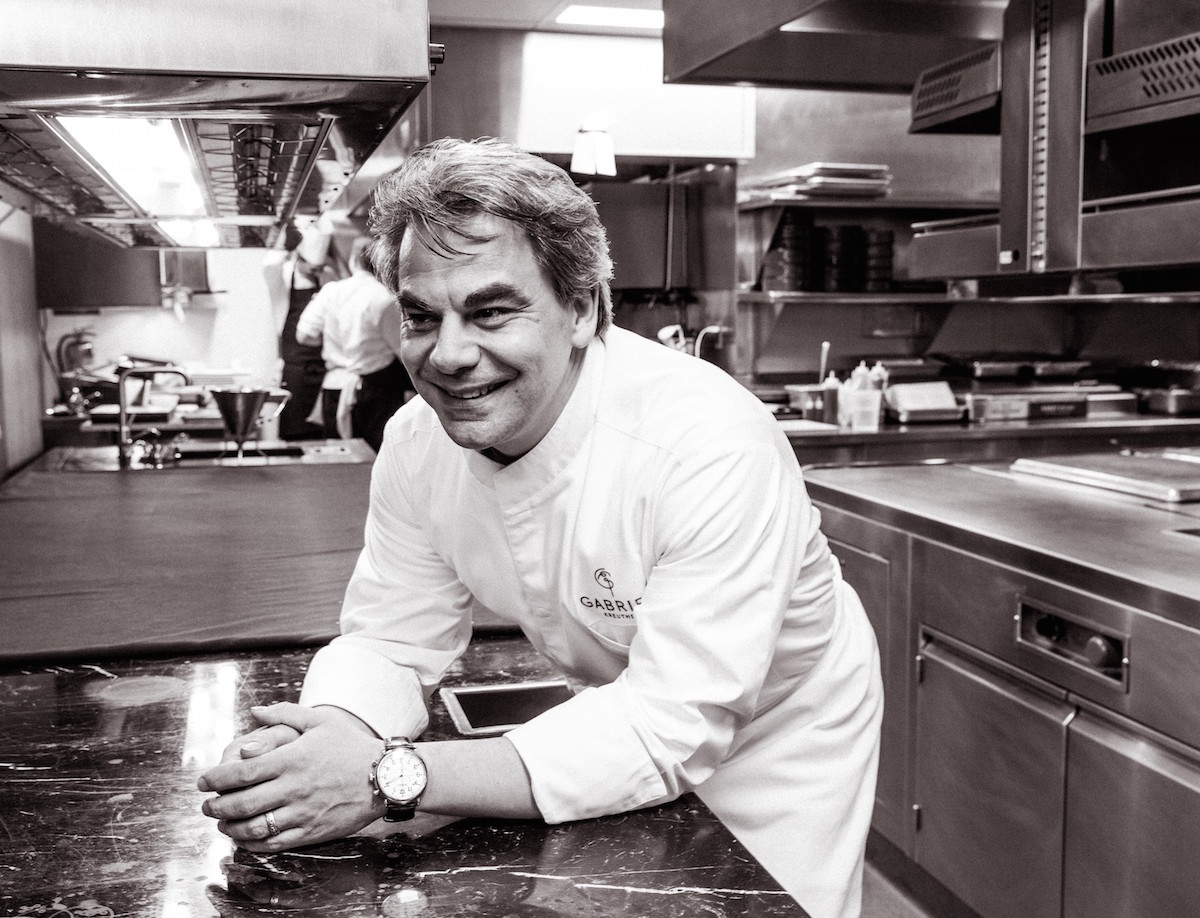 Peek
into
the glassed-in kitchen and you’ll see a
brigade all in traditional crisp white chef''s
coats—no t-shirts, no sandals, no cargo
shorts, no earphones channeling hip-hop. In
such a place as this, pride of professionalism
trumps trendiness.
Peek
into
the glassed-in kitchen and you’ll see a
brigade all in traditional crisp white chef''s
coats—no t-shirts, no sandals, no cargo
shorts, no earphones channeling hip-hop. In
such a place as this, pride of professionalism
trumps trendiness.
Now that I
have set the stage for dinner, let me say that
GK’s cuisine continues to impress by
refinement and detail, from the very Alsatian
tartes
flambée served at the bar-lounge to the
wispy applewood smoke in a bell jar lifted
from a course of sturgeon and sauerkraut with
American caviar mousseline. Kreuther
has kept this and other signature dishes on
the menu, including the ethereal langoustine
tartare with flying fish roe, cauliflower, and
a lush macadamia puree. The
continuing service of various breads is
also—thank heavens—maintained, for there
simply are no better breads in NYC, from the
herbed buckwheat House rolls to the nicely
chewy baguette.
Colorful amuses
live up to their name.
Now the crispy sweetbreads
are roasted in duck fat with honshimeji
mushrooms, pancetta
and mildly spicy pasilla chilies. The
sight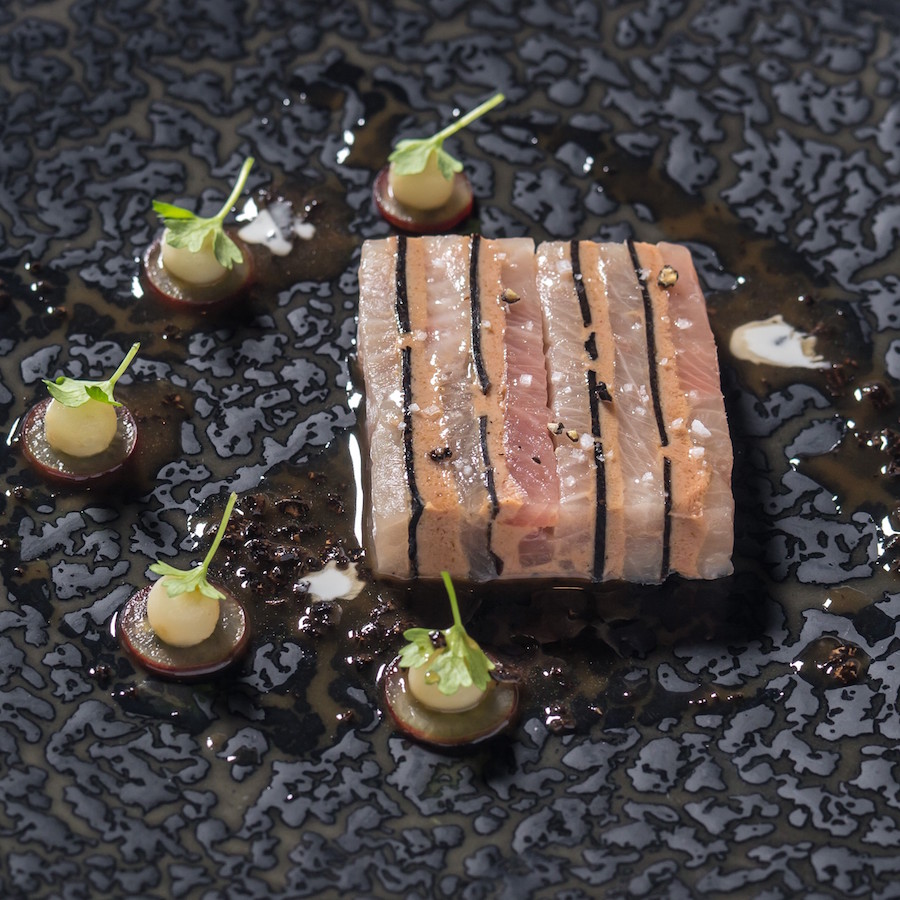 of
Everglades frogs’ legs cooked in a Mason jar
is odd, but with woodsy chanterelles, zucchini
and puffed farro, the dish is a little
masterpiece of taste and textures and fun to
scoop out.
On a summer’s eve, there can be nothing
better than Kreuther’s chilled honeydew melon
soup with husk cherries, dried tomatoes and
cantaloupe, and his classic training shows
impeccably in a terrine of creamy foie gras
with brittle black truffled praline, Muscat
jelly and seven grain toast. There is never a
jarring note on any plate, no surprise for the
sake of it.
of
Everglades frogs’ legs cooked in a Mason jar
is odd, but with woodsy chanterelles, zucchini
and puffed farro, the dish is a little
masterpiece of taste and textures and fun to
scoop out.
On a summer’s eve, there can be nothing
better than Kreuther’s chilled honeydew melon
soup with husk cherries, dried tomatoes and
cantaloupe, and his classic training shows
impeccably in a terrine of creamy foie gras
with brittle black truffled praline, Muscat
jelly and seven grain toast. There is never a
jarring note on any plate, no surprise for the
sake of it.
Among the main courses, I
love the pork tenderloin with fennel, roasted
broccolini and pickled mustard seeds, while
duck came with breast and confit-ed leg
touched with chamomile oil in a spiced
consommé—a dish as contemporary as anything in
town. But
in every dish, in the way it is conceived and
presented—the drizzle of jus,
the pour of broth, the minimal explanation by
the captain—there is elegance and a dexterity
that shows the depth of the entire staff.
Kreuther is one of those chefs who is always
in his kitchen, so he hovers over his cooks to
make sure all goes well.
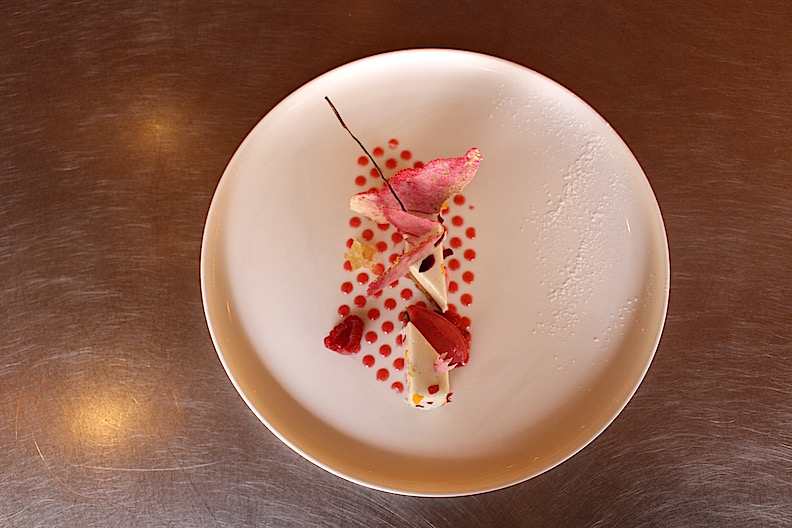 This most certainly
includes the dessert kitchen under Marc Aumont
(his sous-patîssiére is my daughter-in-law, so
I’m well familiar with the detail work and
complexity of the desserts, chocolates and
petit-fours).
Some sound simple, like a
vanilla-coconut pannacotta with fresh
pineapple and sorbet, but there are ten
flavors within that sorbet. Sauté
cherries come with an almond mousseline and
perfect sable
Bréton.
And white chocolate mousse (left),
which seems to have disappeared from dessert
menus 20 years ago, has been marvelously
restored to life with a bergamot marmalade and
raspberry sorbet.
This most certainly
includes the dessert kitchen under Marc Aumont
(his sous-patîssiére is my daughter-in-law, so
I’m well familiar with the detail work and
complexity of the desserts, chocolates and
petit-fours).
Some sound simple, like a
vanilla-coconut pannacotta with fresh
pineapple and sorbet, but there are ten
flavors within that sorbet. Sauté
cherries come with an almond mousseline and
perfect sable
Bréton.
And white chocolate mousse (left),
which seems to have disappeared from dessert
menus 20 years ago, has been marvelously
restored to life with a bergamot marmalade and
raspberry sorbet.
At the end of an
evening at GK, you’ll realize several things:
First, fine dining is alive and well in NYC;
second, as Marc Aumont told me, this kind of
excellence is inspiring a young generation of
cooks (“They are the future.”); and third, you
will leave the dining room not only well fed
and well cared for but feeling you have had a
share in something rare and special.
Open
for lunch Mon.-Fri.; Dinner Mon.-Sat.
❖❖❖
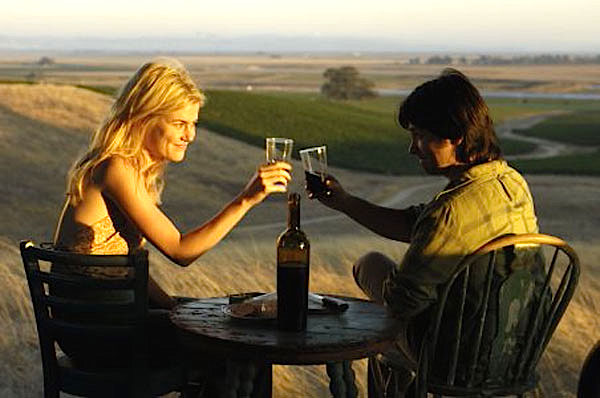 PLEASANTRIES
PLEASANTRIESBy John Mariani
Sometimes—often,
actually—it’s better not to think too much
about the wine you are drinking and just enjoy
it for what it is. Special in small ways,
refreshing, surprising, appealing because you
don’t have
to think about it. And in summer that’s the
philosophy I generally follow when it’s 95
degrees outside and I haven’t the energy to be
highly critical. Here are some wines I’m
enjoying right now.
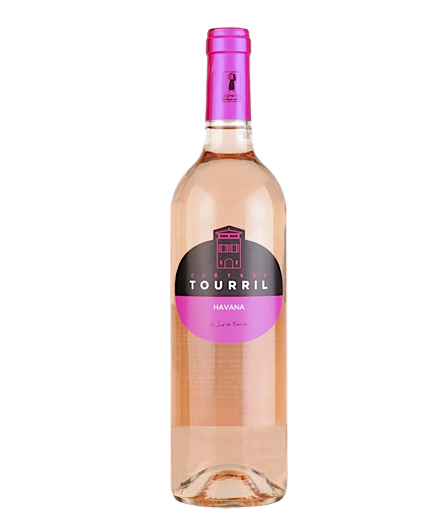 CHÂTEAU
TOURRIL HAVANA 2015 ($12)—Located near
Carcassone in the Languedoc, Château Tourril is
just 32 acres in size and its name is taken from
a Gallo-Roman tower on the property. The
owner likes calling his wines after Cuban
cigars, hence Havana, a rosé made from Minervois
grapes like Cinsault, Carignan, Roussillon and
Grenache that give it a cheery color and bright
flavor. It’s wonderful as an aperitif or with a
crab salad, especially while listening to Soeur
Sourire sing “Dominique” in the background.
CHÂTEAU
TOURRIL HAVANA 2015 ($12)—Located near
Carcassone in the Languedoc, Château Tourril is
just 32 acres in size and its name is taken from
a Gallo-Roman tower on the property. The
owner likes calling his wines after Cuban
cigars, hence Havana, a rosé made from Minervois
grapes like Cinsault, Carignan, Roussillon and
Grenache that give it a cheery color and bright
flavor. It’s wonderful as an aperitif or with a
crab salad, especially while listening to Soeur
Sourire sing “Dominique” in the background.
CHÂTEAU
MESSILE-AUBERT
2009 ($20-$25)—A Grand Cru Classé
Montagne Saint-Émilion, Messile-Aubert is made
from 80% merlot, 20% Cabernet Franc, and 20%
Cabernet Sauvignon. It’s very smooth,
unprovocative, and an apt choice for anything
you toss on the grill this summer. Its
age has provided balance, with the tannins
mellowed out, but somehow I find it difficult to
taste the “crushed rocks” that Wine
Advocate does.
TASCANTE
BUONORA
2014 ($20)—The Carricante grape is showing good
promise in 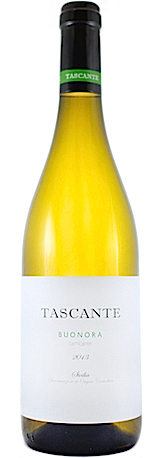 Sicilian
vineyards like this one, both fermented and
briefly aged in stainless steel to give it as
fresh a profile as you could wish for in summer. Tascante
is one label of the 1,480-acre Tasca d’Almarita
estate dating back two centuries, and this
bottling comes from grapes grown around Mount
Etna, so it picks up minerality in abundance.
Still, no crushed rocks.
Sicilian
vineyards like this one, both fermented and
briefly aged in stainless steel to give it as
fresh a profile as you could wish for in summer. Tascante
is one label of the 1,480-acre Tasca d’Almarita
estate dating back two centuries, and this
bottling comes from grapes grown around Mount
Etna, so it picks up minerality in abundance.
Still, no crushed rocks.
CHÂTEAU
SAINT-MAUR
2015 ($25)—Just a tad high for a rosé but, at
13% alcohol, it has more body and aromatics than
many from the Côtes de Provence, this one
specifically from around Golfe de Saint-Tropez.
It really is more pink than rose-colored, and
the fruit component is well complemented by its
citrus acids. The wine is made from 54%
Grenache, 26% Cinsault, 13% Carignan, 2%
each Mouvèdre and Cabernet Franc for the body,
and 1% each Syrah, Ugni Blanc, and Rolle for
complexity. It’s the kind of wine you remember
drinking on your first visit to the French
Riviera when you were either in love or longing
to be so.
 MURPHY-GOODE LIAR’S DICE ZINFANDEL
2013 ($21)—“This wine is no roll of the dice,”
reads the label. “It’s a sure-fire winner.” Fair
enough. (The
name comes from games of Liar’s Dice co-founder
Tim Murphy played with Sonoma County growers.)
It’s a big, bold zin, briary and lip-smacking,
and if you drink it with anything that has a
char on it, you’ll be very happy indeed. Slosh
it into the glass. Good price, too.
MURPHY-GOODE LIAR’S DICE ZINFANDEL
2013 ($21)—“This wine is no roll of the dice,”
reads the label. “It’s a sure-fire winner.” Fair
enough. (The
name comes from games of Liar’s Dice co-founder
Tim Murphy played with Sonoma County growers.)
It’s a big, bold zin, briary and lip-smacking,
and if you drink it with anything that has a
char on it, you’ll be very happy indeed. Slosh
it into the glass. Good price, too.
MASSOVIVO
AMMIRAGLIA
VERMENTINO 2014 ($18)—Made by the Frescobaldi
family of Tuscany, this shows off how a commonly
bland white grape, Vermentino, can show its
character (Massovivo
means “living rock,” a nickname for the
Ammiraglia terroir). With a fine 13% alcohol,
the wine emerges from four months in stainless
steel and one in bottle. Just about any seafood
will match well with this sprightly wine, but it
would be equally good with a vegetable-based
pasta.
DOMAINE
GEROVASSILIOU AVATON 2012 ($60)—The name Avaton means
“inviolable and sacred,” which seems a stretch,
but this is an impressive modern red wine of
Greece, made from ancient but unfamiliar
grapes--Limnio,
Mavrotragano,
and Mavroudi—which makes it at the least a
curiosity and at best the kind of hearty,
layered red wine at just 14% alcohol that will
be perfect with roasted or grilled lamb and
warm pita bread. Still, at $60 in U.S wine
shops (much less in the UK), it’s not a wine
to uncork too casually.
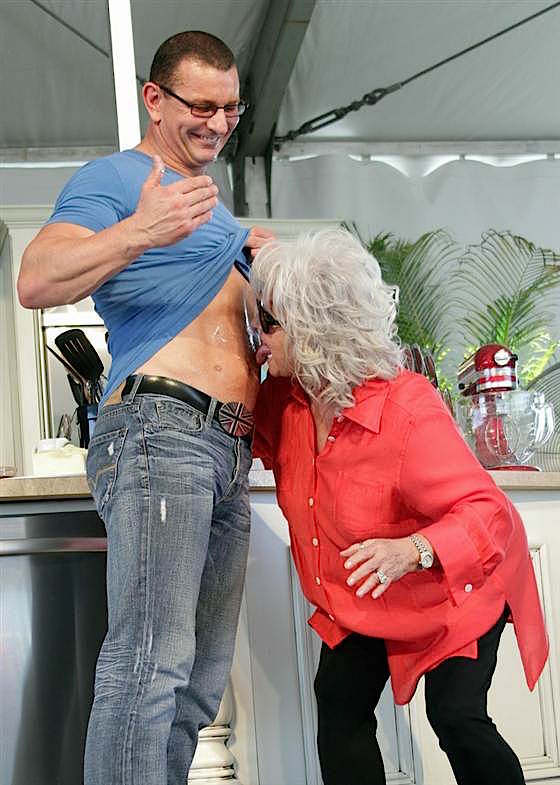
FURTHER EVIDENCE--AS IF WE NEEDED IT!-- OF
THE DECLINE OF AMERICAN CIVILIZATION
Robert Irvine
(left, with Paula Deen),
star of the TV show Restaurant: Impossible star
will be getting a new show described as "Dr.
Phil–esque" called simply Robert Irvine,
to air on the CW network
in the weekday 3 p.m. time slot. The show will be
built around one-on-ones with
"chef-therapist" Irvine "dishing up tough-love
advice and conflict resolution options"
after "making people understand what they're doing
wrong."
FOOD WRITING 101: Less Is More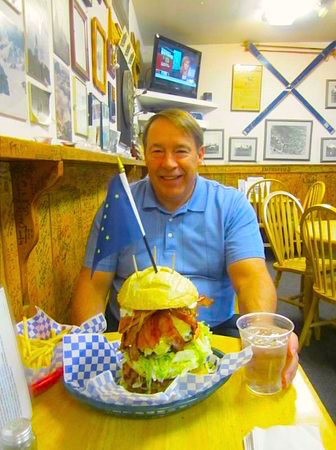
“Seward's
Folly at West Rib Pub
and Grill, Talkeetna Alaska: This bad boy touts
itself as being the biggest burger in Alaska and
considering it weighs in around 5 pounds, we can't
disagree. Topped with over 2 pounds of Caribou burger,
sliced ham, 12 pieces of bacon, 12 slices of cheese,
lettuce, tomato, and grilled onions, and smothered in
West Rib's famous `Fat Ass’ sauce, anyone who can eat
this all within an hour earns the title of Master and
gets a free T-shirt.”—Shana Lynch,” The Most
Over-The-Top Burgers In Every State,” Esquire.com
❖❖❖
Sponsored by Banfi Vintners
Poggio
alle Mura Rosso di Montalcino
By
John Fodera, TuscanVine.com
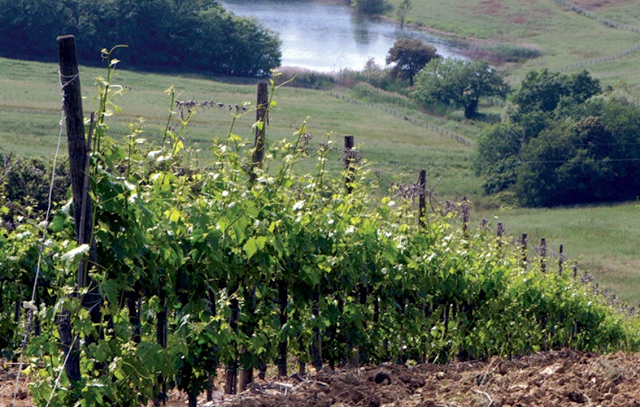 In 1992,
Castello Banfi planted the Poggio Alle
Mura vineyard after over 10 years of Sangiovese clonal
research that determined
which clones where most properly suited to the
vineyard based upon soil
composition, elevation and exposition. Today
that vineyard is almost 25
years of age and bearing the best grapes it has ever
produced.
In 1992,
Castello Banfi planted the Poggio Alle
Mura vineyard after over 10 years of Sangiovese clonal
research that determined
which clones where most properly suited to the
vineyard based upon soil
composition, elevation and exposition. Today
that vineyard is almost 25
years of age and bearing the best grapes it has ever
produced.
This "maturation" is exemplified by
the creation of two additional wines in Castello
Banfi's portfolio. Originally
planted to create a unique expression of Brunello
only, in optimal
vintages the estate is now producing a second Brunello
Riserva and a vineyard
designated Rosso di Montalcino. The result have
been impressive. 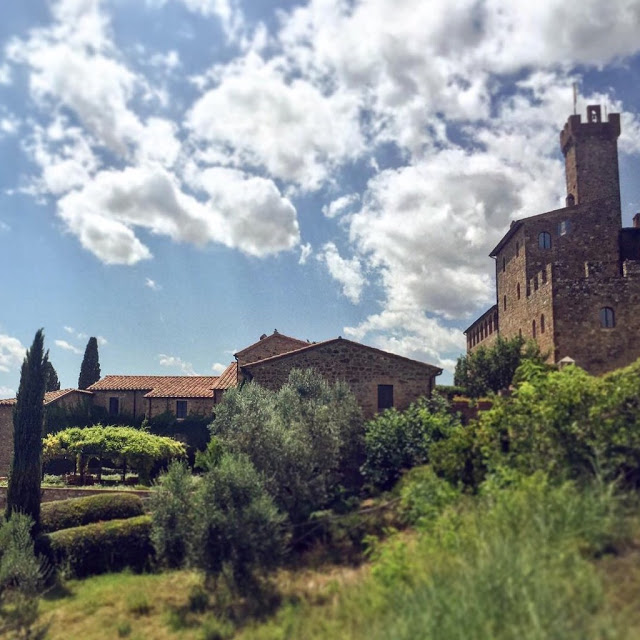
The
2013 Poggio Alle Mura Rosso di Montalcino
opened my eyes. I
have to admit, while I enjoy Rosso di Montalcino in
general, I don't
often find one that surprises me, but this one
did. The wine is vinified in Castello
Banfi's hybrid
stainless steel and oak fermentors for 7-10 days and
then racked to French oak
barrique for 12 months. In fact, the
distinction between the Poggio
Alle Mura and it's sibling estate Rosso di Montalcino
- other than the fruit
source - is the oak aging regimen. While the
estate wine spends 12 months
in a combination of barrique and botte, only barrique
are used for the Poggio
Alle Mura.
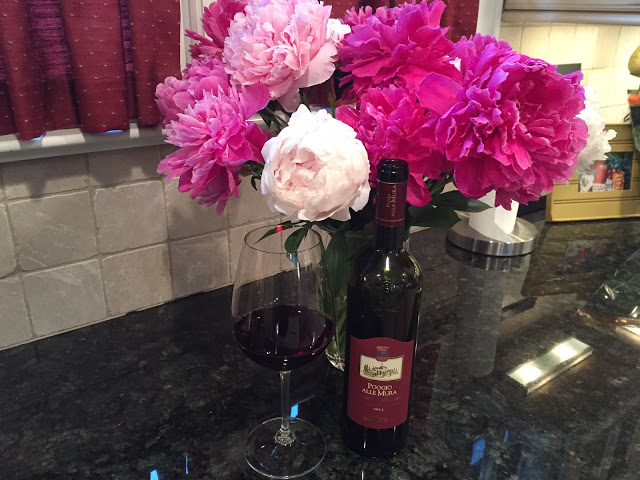 In the glass,
the wine is a deep ruby color.
Lovely, expressive and almost delicate
aromas lift from the glass
with little coaxing. Floral notes, crushed
cherry, spice and fresh herbs
form the bouquet that will carry through onto the
palate. In the mouth,
the wine is medium to full bodied; there is very nice
ripe, weighty fruit to
this Rosso. Vibrant and fresh, with refreshing
acidity, the core of
cherry fruit is strong but graceful at once.
There are few nits to pick
with this. A really wonderful example of the
type. 91 points.
About $24-$28.
In the glass,
the wine is a deep ruby color.
Lovely, expressive and almost delicate
aromas lift from the glass
with little coaxing. Floral notes, crushed
cherry, spice and fresh herbs
form the bouquet that will carry through onto the
palate. In the mouth,
the wine is medium to full bodied; there is very nice
ripe, weighty fruit to
this Rosso. Vibrant and fresh, with refreshing
acidity, the core of
cherry fruit is strong but graceful at once.
There are few nits to pick
with this. A really wonderful example of the
type. 91 points.
About $24-$28.
Any of John Mariani's books below may be ordered from amazon.com.
 The
Hound in Heaven (21st Century Lion Books)
is a novella, and for anyone who loves dogs,
Christmas, romance, inspiration, even the supernatural, I
hope you'll find this to be a treasured favorite.
The story concerns how, after a New England teacher,
his wife and their two daughters adopt a stray puppy found
in their barn in northern Maine, their lives seem full of
promise. But when tragedy strikes, their wonderful dog
Lazarus and the spirit of Christmas are the only things
that may bring his master back from the edge of
despair.
The
Hound in Heaven (21st Century Lion Books)
is a novella, and for anyone who loves dogs,
Christmas, romance, inspiration, even the supernatural, I
hope you'll find this to be a treasured favorite.
The story concerns how, after a New England teacher,
his wife and their two daughters adopt a stray puppy found
in their barn in northern Maine, their lives seem full of
promise. But when tragedy strikes, their wonderful dog
Lazarus and the spirit of Christmas are the only things
that may bring his master back from the edge of
despair. WATCH THE VIDEO!
“What a huge surprise turn this story took! I was completely stunned! I truly enjoyed this book and its message.” – Actress Ali MacGraw
“He had me at Page One. The amount of heart, human insight, soul searching, and deft literary strength that John Mariani pours into this airtight novella is vertigo-inducing. Perhaps ‘wow’ would be the best comment.” – James Dalessandro, author of Bohemian Heart and 1906.
“John Mariani’s Hound in Heaven starts with a well-painted portrayal of an American family, along with the requisite dog. A surprise event flips the action of the novel and captures us for a voyage leading to a hopeful and heart-warming message. A page turning, one sitting read, it’s the perfect antidote for the winter and promotion of holiday celebration.” – Ann Pearlman, author of The Christmas Cookie Club and A Gift for my Sister.
“John Mariani’s concise, achingly beautiful novella pulls a literary rabbit out of a hat – a mash-up of the cosmic and the intimate, the tragic and the heart-warming – a Christmas tale for all ages, and all faiths. Read it to your children, read it to yourself… but read it. Early and often. Highly recommended.” – Jay Bonansinga, New York Times bestselling author of Pinkerton’s War, The Sinking of The Eastland, and The Walking Dead: The Road To Woodbury.
“Amazing things happen when you open your heart to an animal. The Hound in Heaven delivers a powerful story of healing that is forged in the spiritual relationship between a man and his best friend. The book brings a message of hope that can enrich our images of family, love, and loss.” – Dr. Barbara Royal, author of The Royal Treatment.
 |
The Encyclopedia of American Food and Drink by John F. Mariani (Bloomsbury USA, $35) Modesty forbids me to praise my own new book, but let me proudly say that it is an extensive revision of the 4th edition that appeared more than a decade ago, before locavores, molecular cuisine, modernist cuisine, the Food Network and so much more, now included. Word origins have been completely updated, as have per capita consumption and production stats. Most important, for the first time since publication in the 1980s, the book includes more than 100 biographies of Americans who have changed the way we cook, eat and drink -- from Fannie Farmer and Julia Child to Robert Mondavi and Thomas Keller. "This book is amazing! It has entries for everything from `abalone' to `zwieback,' plus more than 500 recipes for classic American dishes and drinks."--Devra First, The Boston Globe. "Much needed in any kitchen library."--Bon Appetit. |
"Eating Italian will never be the same after reading John Mariani's entertaining and savory gastronomical history of the cuisine of Italy and how it won over appetites worldwide. . . . This book is such a tasteful narrative that it will literally make you hungry for Italian food and arouse your appetite for gastronomical history."--Don Oldenburg, USA Today. "Italian
restaurants--some good, some glitzy--far
outnumber their French rivals. Many of
these establishments are zestfully described
in How Italian Food Conquered the World, an
entertaining and fact-filled chronicle by
food-and-wine correspondent John F.
Mariani."--Aram Bakshian Jr., Wall Street
Journal.
"Equal parts
history, sociology, gastronomy, and just
plain fun, How Italian Food Conquered the
World tells the captivating and delicious
story of the (let's face it) everybody's
favorite cuisine with clarity, verve and
more than one surprise."--Colman Andrews,
editorial director of The Daily
Meal.com. "A fantastic and fascinating
read, covering everything from the influence
of Venice's spice trade to the impact of
Italian immigrants in America and the
evolution of alta cucina. This book will
serve as a terrific resource to anyone
interested in the real story of Italian
food."--Mary Ann Esposito, host of PBS-TV's
Ciao
Italia. "John Mariani has written the
definitive history of how Italians won their
way into our hearts, minds, and
stomachs. It's a story of pleasure over
pomp and taste over technique."--Danny Meyer,
owner of NYC restaurants Union Square
Cafe, The Modern, and Maialino.
|
 |
 |
 |
 |
 |
 |
 |
 |
 Everett Potter's Travel Report:
Everett Potter's Travel Report: 
 Eating Las Vegas
JOHN CURTAS has been covering the Las Vegas
food and restaurant scene since 1995. He is
the co-author of EATING LAS VEGAS – The 50
Essential Restaurants (the fourth
edition of which will be published in early
2016), as well as the author of the Eating Las
Vegas web site: www.eatinglasvegas.
He can also be seen every Friday morning as
the “resident foodie” for Wake Up With the
Wagners on KSNV TV (NBC) Channel 3 in
Las Vegas.
Eating Las Vegas
JOHN CURTAS has been covering the Las Vegas
food and restaurant scene since 1995. He is
the co-author of EATING LAS VEGAS – The 50
Essential Restaurants (the fourth
edition of which will be published in early
2016), as well as the author of the Eating Las
Vegas web site: www.eatinglasvegas.
He can also be seen every Friday morning as
the “resident foodie” for Wake Up With the
Wagners on KSNV TV (NBC) Channel 3 in
Las Vegas.

MARIANI'S VIRTUAL GOURMET
NEWSLETTER is published weekly. Editor/Publisher: John
Mariani.
Editor: Walter Bagley. Contributing Writers: Christopher Mariani,
Robert Mariani, Misha
Mariani,
John A. Curtas, Edward Brivio, Mort Hochstein,
Andrew Chalk, Dotty Griffith and Brian Freedman. Contributing
Photographers: Galina Dargery, Bobby
Pirillo. Technical Advisor: Gerry McLoughlin.
To un-subscribe from this newsletter,click here.
© copyright John Mariani 2016

